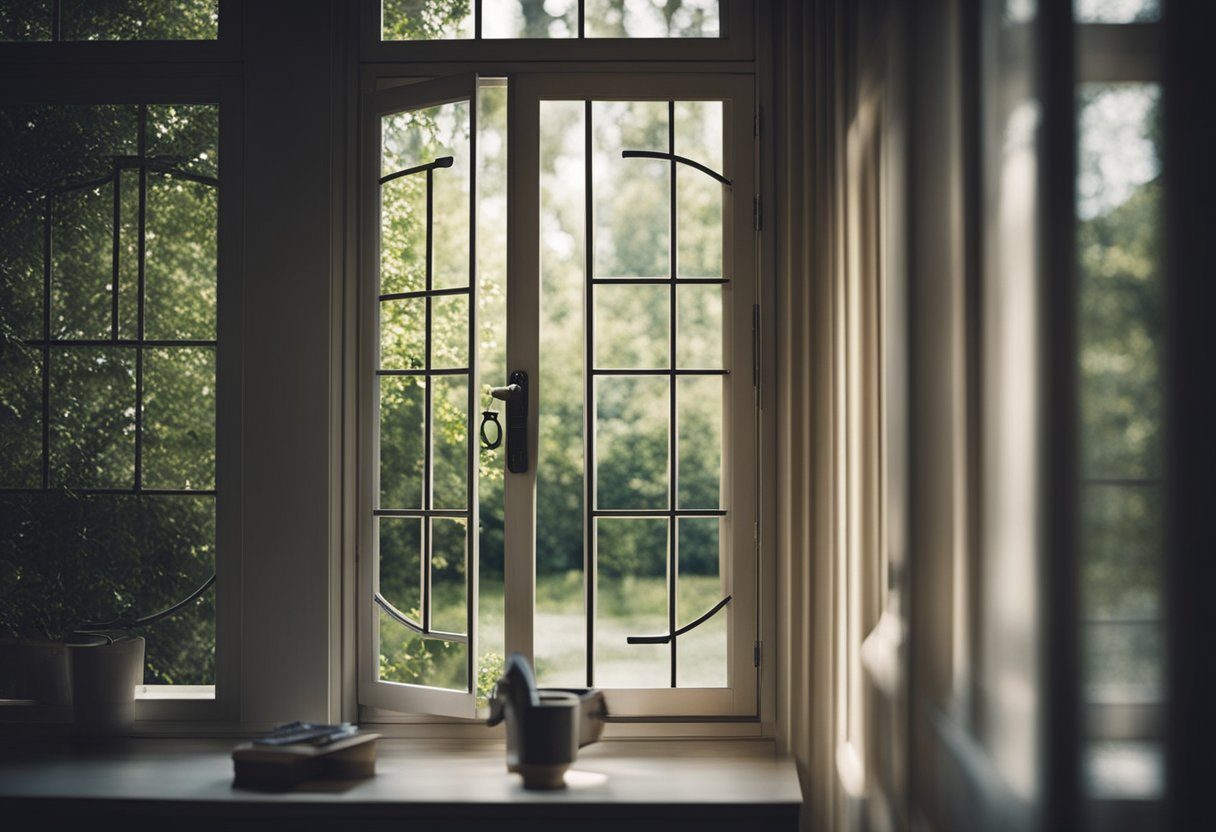Closing up a window is a common home improvement project that can be done for a variety of reasons. Whether you want to remove an old, drafty window, or simply want to block out an unpleasant view, closing up a window can be a cost-effective solution. In this article, I will discuss the various methods of closing windows, as well as some tips and tricks for securing and insulating them.
Understanding windows is an important first step in closing them up. Windows are typically made up of a frame, glass, and hardware, and they come in a variety of styles and sizes. Before you begin closing up a window, it’s important to understand how it works and what materials it’s made of. This will help you choose the best method for closing the window and ensure that it’s done correctly.
Methods of closing windows vary depending on the type of window and the reason for closing it. Some common methods include covering the window with siding, brick, or drywall, or using a window insulation kit to seal it shut. In the following sections, I will discuss these methods in more detail and provide step-by-step instructions for each one.
Key Takeaways
- Understanding the type and materials of your window is important before closing it.
- There are several methods of closing windows, including covering them with siding or insulation kits.
- Securing and insulating a closed window can help improve energy efficiency and block out noise.
Understanding Windows
As a homeowner, it is essential to understand the different parts of a window to make informed decisions when it comes to repairing or replacing them. A window consists of several components, including the frame, sash, glass, and hardware. The frame is the outermost part of the window that provides support and holds the sash and glass in place. The sash is the part of the window that moves and holds the glass. The glass is the transparent material that allows light to enter the room. Hardware refers to the locks, hinges, and other mechanisms that allow the window to open and close.
When it comes to closing up a window, it is essential to understand the type of window you have and its components. For instance, a double-hung window has two sashes that slide up and down, while a casement window has a sash that swings open like a door. It is also crucial to understand the type of siding and paneling used on the exterior and interior of the window.
Before closing up a window, it is essential to remove the interior casing and exterior aluminum cladding/trim to access the window frame. This process may vary depending on the type of window and the materials used. For instance, a vinyl window may require a different approach than a wood window.
In summary, understanding the different parts of a window is crucial when it comes to closing up a window. It is essential to identify the type of window, the materials used, and the components involved to make informed decisions.
Methods of Closing Windows
https://www.youtube.com/watch?v=iyjwiV0Qy9U&embed=true
When it comes to closing a window, there are a few methods you can use. In this section, I will discuss two of the most common methods: the manual method and using keyboard shortcuts.
Manual Method
The manual method of closing a window is the most basic and straightforward method. All you need to do is click on the “X” button located in the top-right corner of the window. This will close the window and exit the program.
Using Keyboard Shortcuts
Using keyboard shortcuts is a faster and more efficient way of closing a window. The most popular keyboard shortcut for closing a window in Windows is Alt + F4. Simply press and hold the “Alt” key on your keyboard and then press the “F4” key. This will close the active window.
Using keyboard shortcuts can save you time and increase your productivity. It’s also a great way to avoid using the mouse, which can be helpful if you have a disability or injury that makes using a mouse difficult.
In conclusion, there are two main methods for closing a window: the manual method and using keyboard shortcuts. Both methods are easy to use and can be effective, depending on your preferences. Whether you choose to use the manual method or keyboard shortcuts, closing a window is a simple task that can be done quickly and easily.
Closing Windows on Different Platforms
https://www.youtube.com/watch?v=i6IOhuzl68k&embed=true
Closing windows on different platforms can be a bit confusing, especially if you are switching between operating systems. In this section, I will explain how to close windows on two of the most widely used platforms: Windows 10 and Mac.
Windows 10
Closing windows on Windows 10 is quite simple. You can use any of the following methods:
- Click on the “X” button in the top right corner of the window.
- Use the keyboard shortcut Alt+F4.
- Right-click on the taskbar icon and select “Close window”.
If you have multiple windows open, you can also use the Task View feature to close them quickly. To do this, click on the Task View button on the taskbar or use the keyboard shortcut Windows+Tab. From there, you can click on the “X” button in the top right corner of the window you want to close.
Mac
Closing windows on a Mac is slightly different than on Windows. Here are a few methods you can use:
- Click on the red button in the top left corner of the window.
- Use the keyboard shortcut Command+W to close the current window.
- Use the keyboard shortcut Command+Option+W to close all windows of the current app.
If you have a trackpad or a Magic Mouse, you can also use gestures to close windows. For example, you can swipe up with three fingers to open Mission Control, where you can close windows by clicking on the “X” button.
In conclusion, closing windows on different platforms is not difficult once you know the right methods. By following the steps outlined above, you can quickly and easily close windows on both Windows 10 and Mac.
Closing Browser Windows
https://www.youtube.com/watch?v=zjCt1P-F86w&embed=true
As a frequent internet user, I often find myself with multiple browser windows open at once. Sometimes, I need to close a window quickly to move on to a new task. In this section, I will provide instructions on how to close browser windows in the most popular browsers: Chrome, Firefox, Safari, and Microsoft Edge.
Chrome
To close a window in Chrome, you can either click on the “x” icon in the top-right corner of the window or use the keyboard shortcut Ctrl + Shift + W. You can also use the “File” menu and select “Close Window” or right-click on the tab you want to close and select “Close Window.”
Firefox
In Firefox, you can close a window by clicking on the “x” icon in the top-right corner of the window or using the keyboard shortcut Ctrl + Shift + W. You can also use the “File” menu and select “Close Window” or right-click on the tab you want to close and select “Close Window.”
Safari
To close a window in Safari, you can either click on the “x” icon in the top-left corner of the window or use the keyboard shortcut Command + W. You can also use the “File” menu and select “Close Window” or right-click on the tab you want to close and select “Close Window.”
Microsoft Edge
In Microsoft Edge, you can close a window by clicking on the “x” icon in the top-right corner of the window or using the keyboard shortcut Ctrl + Shift + W. You can also use the “File” menu and select “Close Window” or right-click on the tab you want to close and select “Close Window.”
Overall, closing a browser window is a simple task that can be accomplished in just a few clicks or keystrokes. By following these instructions, you can quickly and easily close a window in your preferred browser.
Troubleshooting Window Closure Issues
https://www.youtube.com/watch?v=38IIV23WXL4&embed=true
If you are having trouble closing your window, there are a few things you can try before calling in a professional. Here are some common troubleshooting steps that you can take to fix the issue.
Force Quit
If your window is stuck and won’t close properly, you can try force quitting the window. This is similar to force quitting an application on your computer. To force quit a window, you should first try to close it normally. If it won’t close, you can press and hold the window’s handle and give it a gentle push or pull. This should force the window to close.
Task Manager
If force quitting the window doesn’t work, you can try using the task manager. This is similar to using the task manager on your computer to close an unresponsive application. To use the task manager to close a window, you should first open the task manager and select the window that you want to close. Then, click on the “End task” button to close the window.
Reset
If force quitting and using the task manager don’t work, you can try resetting the window. This is similar to restarting your computer to fix an issue. To reset the window, you should first remove any obstructions around the window. Then, gently push the window up and down a few times to loosen it up. Finally, try closing the window again.
By following these troubleshooting steps, you may be able to fix the issue with your window’s closure. However, if none of these steps work, it may be time to call in a professional to help you fix the issue.
Securing Closed Windows
As a homeowner, securing your windows is essential to protect your property from intruders. Closing the windows is the first step, but it’s not always enough. Here are a few tips to help you secure your closed windows.
Use Locks
Locks are the most common way to secure closed windows. There are different types of locks available, including sash locks, sliding window locks, and key locks. Sash locks are the most popular and are easy to install. They work by locking the sash in place, preventing it from being opened. Sliding window locks are designed for sliding windows and work by securing the window to the frame. Key locks are the most secure but can be expensive to install.
Add Screws
Adding screws to your windows is another way to secure them. This method is particularly useful for older windows that don’t have locks. To add screws, drill a small hole through the sash and into the frame. Then, insert a screw into the hole. This will prevent the window from being opened from the outside.
Seal the Windows
Sealing your windows is a great way to prevent drafts and also makes it more difficult for intruders to break in. Use weather stripping or caulking to seal any gaps around the windows. This will also help to reduce your energy bills by preventing heat from escaping.
In conclusion, securing closed windows is essential to protect your property. By using locks, adding screws, and sealing the windows, you can make it more difficult for intruders to break in.
Insulating Closed Windows
When it comes to insulating closed windows, there are a few things you can do to ensure that your home stays warm and comfortable during the colder months. Here are some tips to help you insulate your windows:
-
Apply weatherstripping: Weatherstripping is a great way to seal gaps around your windows. It can be made from a variety of materials, including foam, rubber, and vinyl. Simply apply the weatherstripping to the edges of your windows to create a tight seal.
-
Use draft stoppers: Draft stoppers are another way to prevent cold air from entering your home through your windows. These can be placed along the bottom of your windows to create a barrier that will keep out drafts.
-
Install insulated curtains: Insulated curtains are a great way to keep your home warm and cozy. These curtains are made from special materials that help to trap heat inside your home, preventing it from escaping through your windows.
-
Consider installing double-paned windows: Double-paned windows are a great way to increase the insulation of your home. These windows have two layers of glass with a layer of air or gas in between, which helps to prevent heat loss.
-
Install window film: Window film is a thin layer of plastic that can be applied to your windows to help insulate them. This film helps to prevent heat loss and can be easily removed when the weather warms up.
By following these tips, you can help to ensure that your home stays warm and comfortable during the colder months. Whether you choose to use weatherstripping, draft stoppers, insulated curtains, double-paned windows, or window film, there are plenty of ways to insulate your windows and keep your home cozy.
Frequently Asked Questions
https://www.youtube.com/watch?v=kRodbXgOdyA&embed=true
What is the cost to remove a window and close up the opening?
The cost to remove a window and close up the opening varies depending on several factors such as the type of window, the size of the window, and the materials used to close up the opening. On average, the cost can range from $300 to $1,000. It is best to get a quote from a professional contractor for an accurate estimate.
How can I fill in a window opening?
To fill in a window opening, you can use a variety of materials such as drywall, plywood, or cement board. The process involves measuring the opening, cutting the material to size, securing it in place, and finishing it with paint or other materials to match the surrounding area.
What are the steps to close up a window in a brick house?
Closing up a window in a brick house requires careful planning and execution. The steps involve removing the window, preparing the opening, installing a new frame, and finishing the area with brick or other materials to match the surrounding area. It is recommended to hire a professional contractor with experience in working with brick to ensure a proper and safe installation.
How do I cover up an unwanted window from the inside?
To cover up an unwanted window from the inside, you can use a variety of materials such as curtains, blinds, or shutters. The process involves measuring the window, selecting the appropriate material, and installing it securely to cover the window.
How can I cover a window with wood?
To cover a window with wood, you can use a variety of materials such as plywood, lumber, or paneling. The process involves measuring the window, cutting the wood to size, securing it in place, and finishing it with paint or other materials to match the surrounding area.
How do I temporarily cover a window opening?
To temporarily cover a window opening, you can use materials such as cardboard, plastic sheeting, or temporary window film. The process involves measuring the window, cutting the material to size, and securing it in place with tape or other temporary fasteners. It is important to note that temporary coverings are not a permanent solution and may not provide adequate insulation or security.

Hi, I’m Sal Muller of Tooltrip.com. My DIY experience led me to understand essential power tools for home projects. Tooltrip.com guides enthusiasts and professionals in choosing right tools for any job. I provide concise top tool reviews for easier, efficient DIY.





